Spatial Variation of Biomass Carbon Density in a Subtropical Region of Southeastern China
Abstract
:1. Introduction
2. Experimental Section
2.1. Study Area and Sampling Site Description
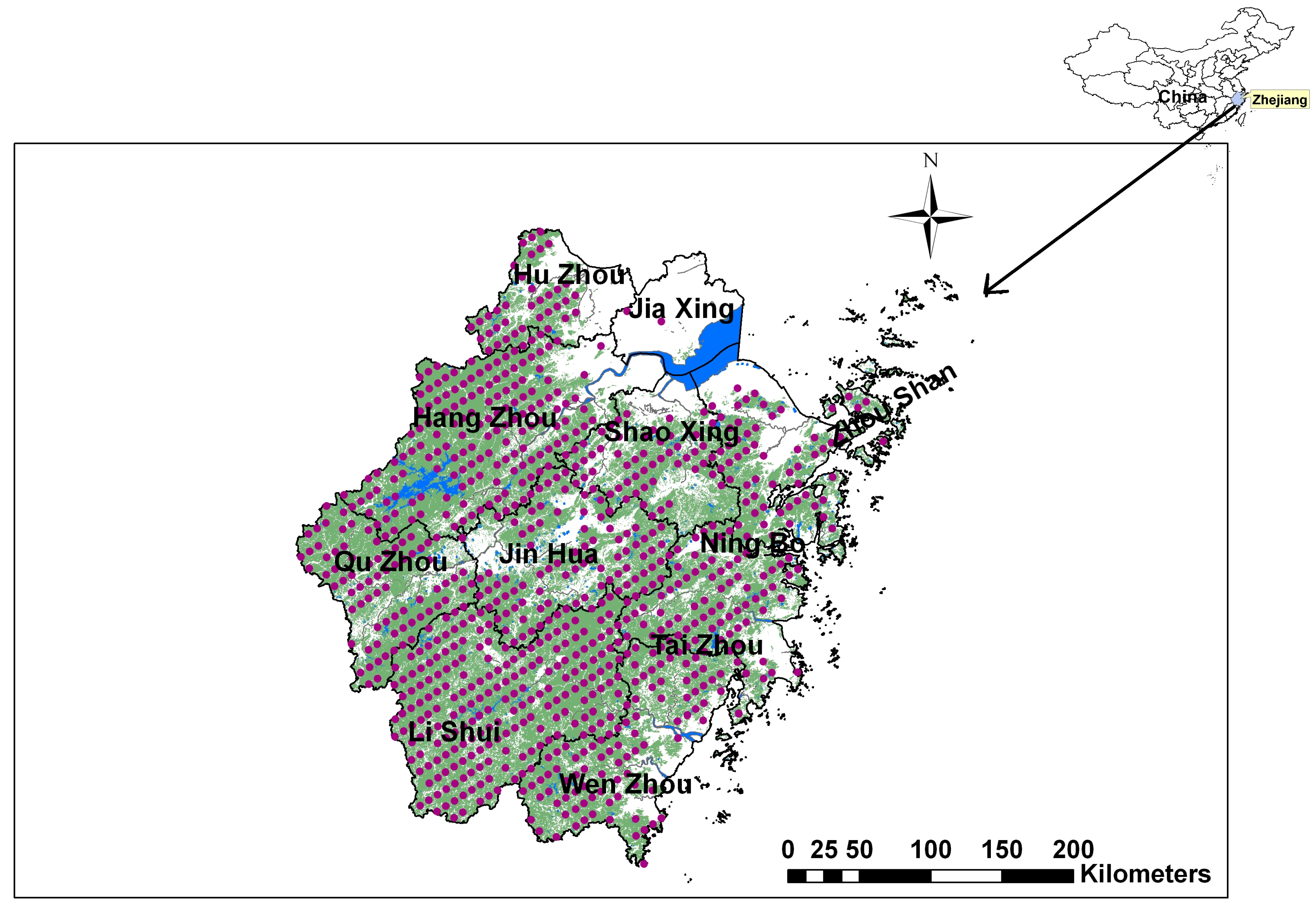
2.2. Data Analysis
3. Results and Discussion
3.1. Descriptive Statistics of Forest Biomass Carbon Density
| Min | 5% | 25% | Median | 75% | 95% | Max | Mean | SD | CV (%) | Skew | Kurt | K-Sp |
|---|---|---|---|---|---|---|---|---|---|---|---|---|
| 0.12 | 1.45 | 13.48 | 22.81 | 37.16 | 142.61 | 182.12 | 27.33 | 20.14 | 73.69 | 1.72 (0.02) | 5.91 (0.68) | 0.00 (0.284) |
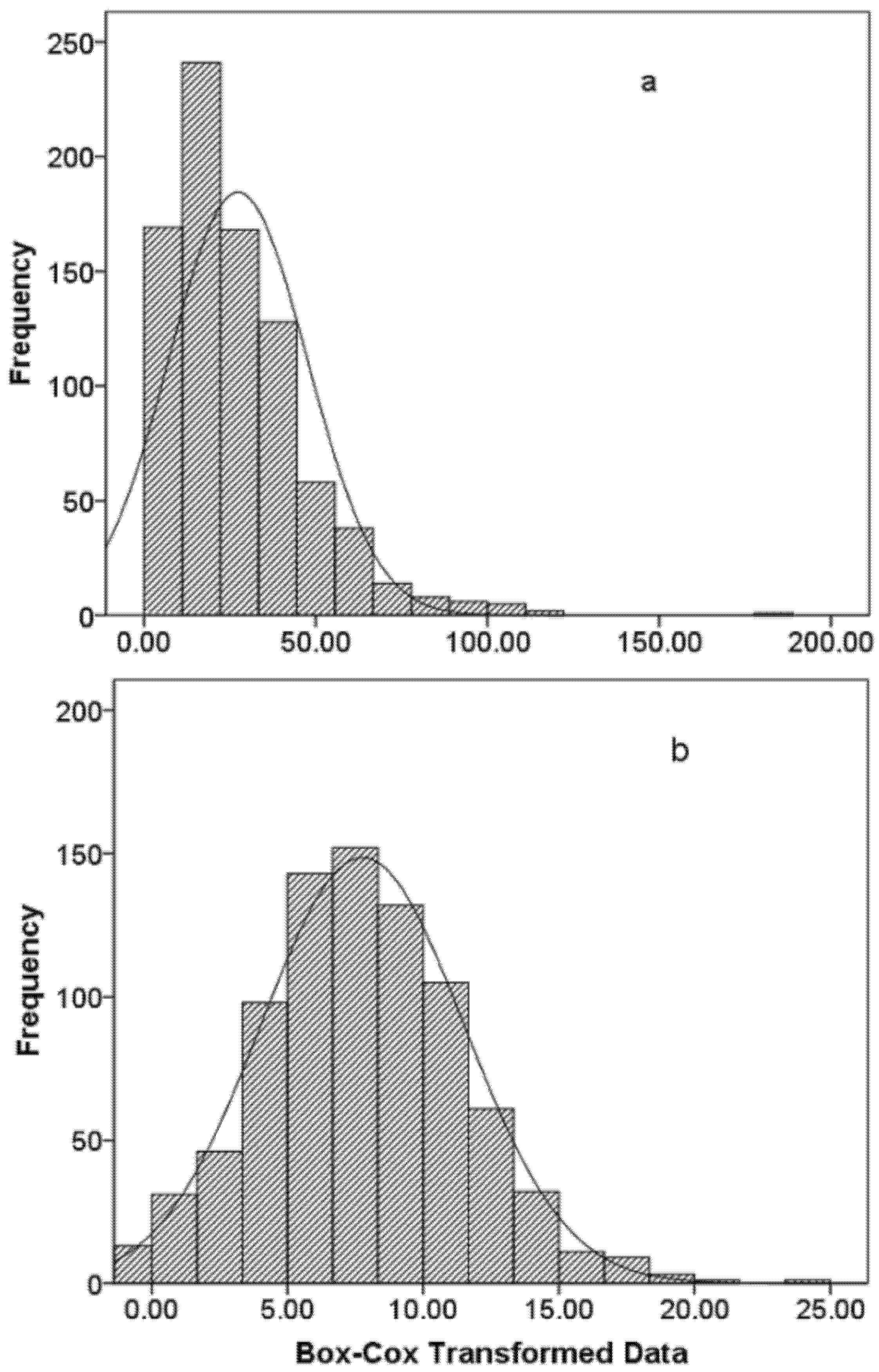
3.2. Spatial Symbol Map of Forest Biomass Carbon Density
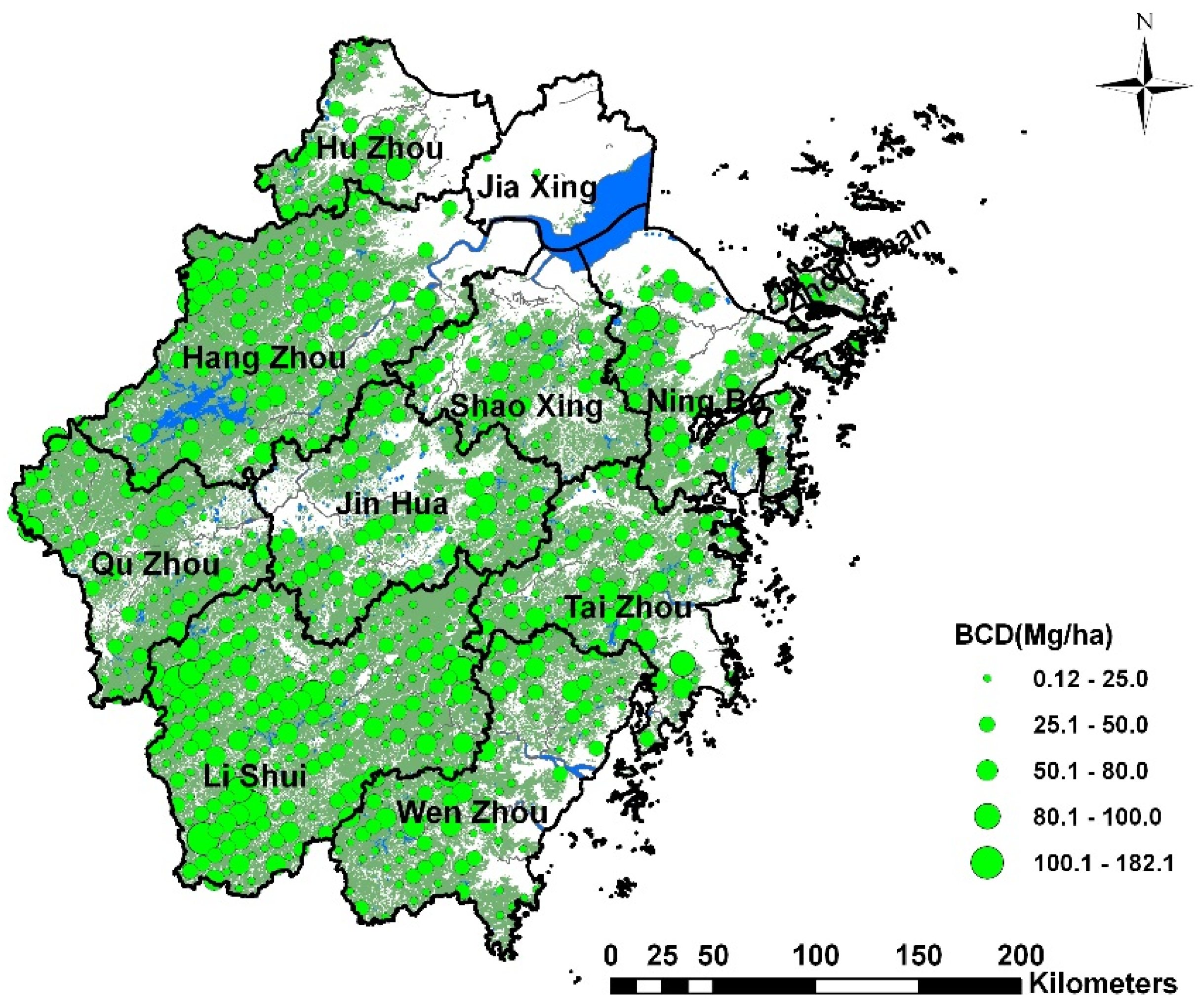
3.3. The Environmental Factors Related to Forest Biomass Carbon Density
| Elevation | Slope aspect | Slope position | Forest age | Forest litter carbon | Soil Organic carbon | Soil Available N | Soil pH | Soil Available P | Soil Available K | |
| FBC | 0.237 ** | 0.003 | −0.166 ** | 0.468 ** | 0.306 ** | 0.176 ** | 0.124 ** | −0.076 * | 0.050 | 0.030 |
| Elevation | −0.351 ** | −0.016 | 0.071 | 0.188 ** | 0.208 ** | 0.268 ** | 0.016 | 0.030 | 0.243 ** | |
| Slope aspect | 0.009 | −0.034 | −0.073 * | −0.037 | −0.024 | 0.025 | 0.014 | −0.021 | ||
| Slope position | −0.136 ** | −0.158 ** | −0.083 * | −0.082 * | 0.152 ** | 0.013 | −0.041 | |||
| Forest age | 0.219 ** | 0.137 ** | 0.074 * | −0.085 * | −0.008 | 0.042 | ||||
| Forest litter carbon | 0.23 ** | 0.157 ** | −0.094 * | −0.01 | 0.005 | |||||
| Soil Organic carbon | 0.589 ** | −0.029 | 0.219 ** | 0.339 ** | ||||||
| Soil Available N | 0.056 | 0.264 ** | 0.405 ** | |||||||
| Soil pH | 0.144 ** | 0.202 ** | ||||||||
| Soil Available P | 0.287 ** |
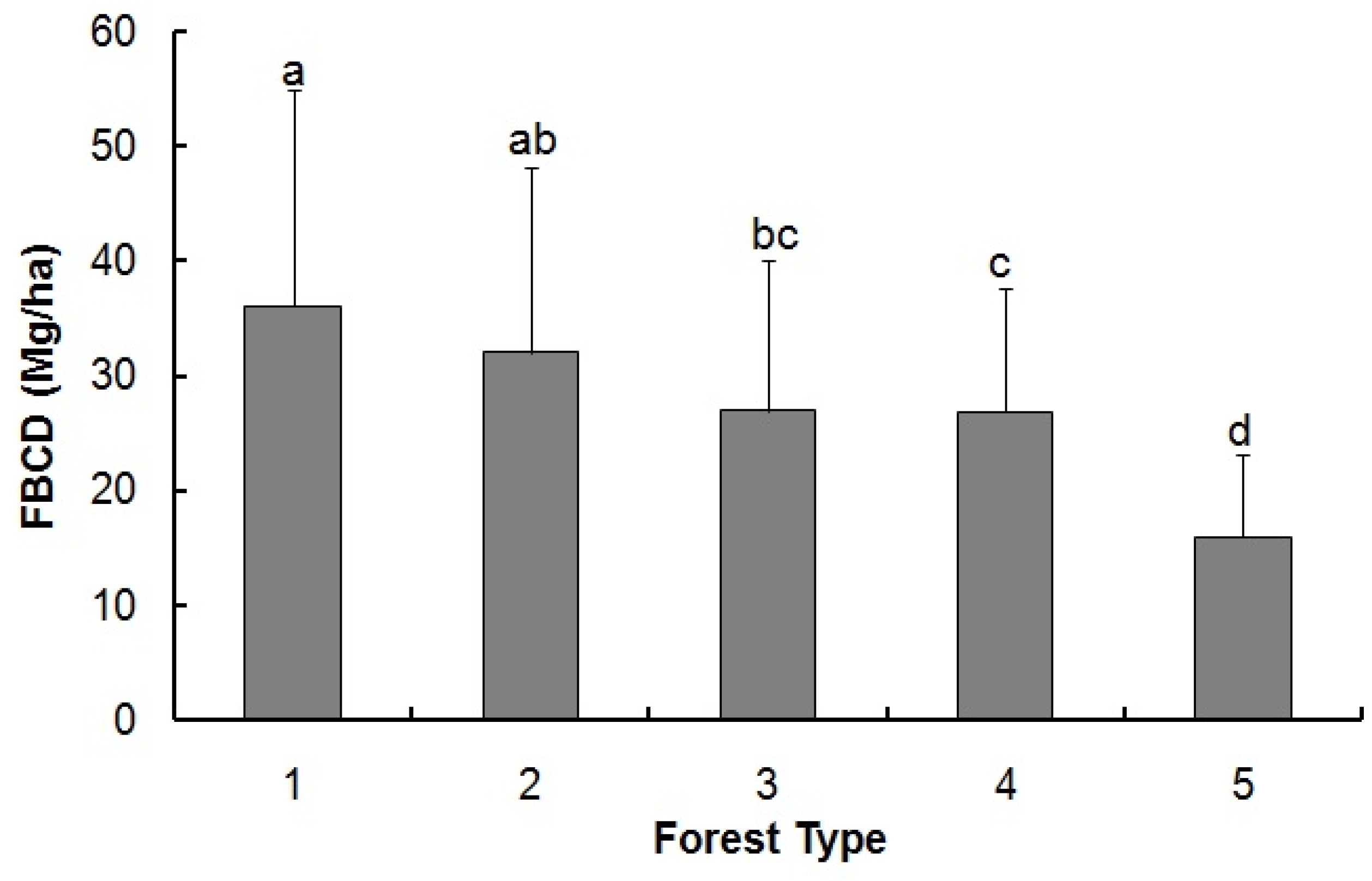
3.4. Spatial-Cluster and Spatial-Outlier Analyses


3.5. Semivariance Analysis and Spatial Distribution
| Data | Models | (Nugget) C0 | (Sill) C0 + C | (Nugget / Sill %) C0/(C0 + C) | Range a (km) | R2 |
|---|---|---|---|---|---|---|
| Box-Cox transformation | Spherical | 0.011 | 0.023 | 47.8 | 98.5 | 0.906 |
| Exponential | 0.014 | 0.024 | 58.3 | 102.4 | 0.875 | |
| Circular | 0.018 | 0.025 | 72.0 | 96.3 | 0.822 | |
| Gaussian | 0.021 | 0.028 | 75.0 | 99.7 | 0.786 |
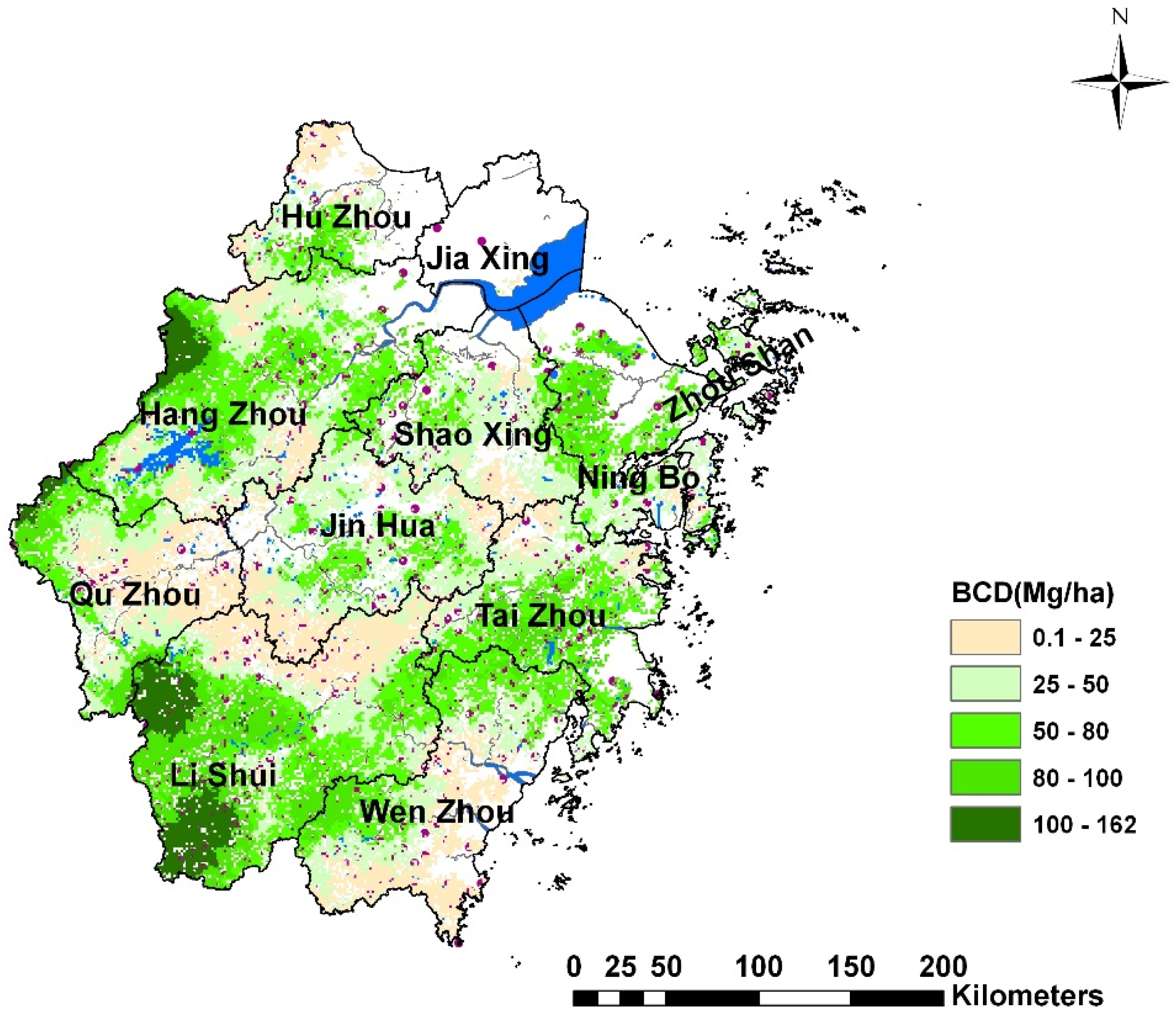
4. Conclusions
Acknowledgments
Author Contributions
Conflicts of Interest
References
- Fu, W.J.; Jiang, P.K.; Zhao, K.L.; Zhou, G.M.; Li, Y.F.; Wu, J.S.; Du, H.Q. The carbon storage in moso bamboo plantation and its spatial variation in Anji county of southeastern China. J. Soils Sediments 2014, 14, 320–329. [Google Scholar] [CrossRef]
- Matysek, A.; Ford, M.; Jakeman, G.; Curtotti, R.; Schneider, K.; Aham-mad, H.; Fisher, B.S. Near Zero Emissions Technologies; ABARE eReport, 05.1; Australian Bureau of Agri-cultural and Resource Economics: Canberra, Australia, 2005. [Google Scholar]
- Stern, N. The Economics of Climate Change: The Stern Review; Cambridge University Press: Cambridge, UK, 2007. [Google Scholar]
- IPCC (Intergovernmental Panel on Climate Change). Summary for policymakers: Land use, land-use change, and forestry. In A Special Report of the Intergovernmental Panel on Climate Change; Watson, R.T., Nobel, I.R., Bolin, B., Ravinddranath, N.H., Verardo, D.J., Dokken, D.J., Eds.; Cambridge University Press: Cambridge, UK, 2000; pp. 4–14. [Google Scholar]
- FAO. Global Ecological Zoning for the Global Forest Resources Assessment; FAO: Rome, Italy, 2000. [Google Scholar]
- Pan, Y.; Birdsey, R.A.; Fang, J.; Houghton, R.; Kauppi, P.E.; Kurz, W.A.; Phillips, O.L.; Shvidenko, A.; Lewis, S.L.; Canadell, J.G.; et al. A large and persistent carbon sink in the world’s forests. Science 2011, 333, 988–993. [Google Scholar] [CrossRef] [PubMed]
- Watson, A.J.; Bakker, D.C.E.; Ridgwell, A.J.; Boyd, P.W.; Law, C.S. Effect of iro supply on southern ocean CO2 uptake and implications for glacial atmospheric CO2. Nature 2000, 407, 730–733. [Google Scholar] [CrossRef] [PubMed]
- Brown, S.L.; Schroeder, P.E. Spatial patterns of aboveground production and mortality of woody biomass for eastern U.S. forests. Ecol. Appl. 1999, 9, 968–980. [Google Scholar]
- Takahashi, M.; Ishizuka, S.; Ugawa, S.; Sakai, Y.; Sakai, H.; Ono, K.; Morisada, K. Carbon stock in litter, deadwood and soil in Japan’s forest sector and its comparison with carbon stock in agricultural soils. Soil Sci. Plant Nutr. 2010, 56, 19–30. [Google Scholar] [CrossRef]
- Piao, S.; Fang, J.; Zhu, B.; Tan, K. Forest biomass carbon stocks in China over the past 2 decades: Estimation based on integrated inventory and satellite data. J. Geophys. Res. 2005, 110, G01006. [Google Scholar] [CrossRef]
- Davis, M.R.; Allen, R.B.; Clinton, P.W. Carbon storage along a stand development sequence in a New Zealand Nothofagus forest. For. Ecol. Manag. 2003, 177, 313–321. [Google Scholar] [CrossRef]
- Fang, J.; Chen, A.; Peng, C.; Zhao, S.; Ci, L. Changes in forest biomass carbon storage in China between 1949 and 1998. Science 2001, 292, 2320–2322. [Google Scholar] [CrossRef] [PubMed]
- Hazlett, P.W.; Gordon, A.M.; Sibley, P.K.; Buttle, J.M. Stand carbon stocks and soil carbon and nitrogen storage for riparian and upland forests of boreal lakes in northeastern Ontario. For. Ecol. Manag. 2005, 219, 56–68. [Google Scholar] [CrossRef]
- Fang, J.; Guo, Z.; Piao, S.; Chen, A. Terrestrial vegetation carbon sinks in China, 1981–2000. Sci. China Ser. D Earth Sci. 2007, 50, 1341–1350. [Google Scholar] [CrossRef]
- Xu, X.L.; Cao, M.K.; Li, K.R. Temporal-spatial dynamics of carbon storage of forest vegetation in China. Prog. Geog. 2007, 27, 1–10. [Google Scholar]
- Guo, Z.; Fang, J.; Pan, Y.; Birdsey, R. Inventory-based estimates of forest biomass carbon stocks in China: A comparison of three methods. For. Ecol. Manag. 2010, 259, 1225–1231. [Google Scholar] [CrossRef]
- Du, L.; Zhou, T.; Zou, Z.; Zhao, X.; Huang, K.; Wu, H. Mapping forest biomass using remote sensing and national forest inventory in China. Forests 2014, 5, 1267–1283. [Google Scholar] [CrossRef]
- Jeffrey, Q.C.; Robinson, N.J.; Daniel, M.M.; Alan, D.V.; Joerg, T.; Dar, R.; Gabriel, H.; Susan, T.; Niro, H. The steady-state mosaic of disturbance and succession across an old-growth central amazon forest landscape. Proc. Nat. Acad. Sci. 2013, 110, 3949–3954. [Google Scholar]
- Wang, Y.Q.; Zhang, X.C.; Zhang, J.L.; Li, S.J. Spatial variability of soil organic carbon in a watershed on the Loess Plateau. Pedosphere 2009, 19, 486–495. [Google Scholar] [CrossRef]
- Vittorio, A.; Negron-Juarez, R.; Higuchi, N.; Chambers, J. Tropical forest carbon balance: Effects of field- and satellite-based mortality regimes on the dynamics and the spatial structure of central amazon forest biomass. Environ. Res. Lett. 2014, 9, 034010. [Google Scholar] [CrossRef]
- Du, H.Q.; Zhou, G.M.; Fan, W.Y.; Ge, H.L.; Xu, X.J.; Shi, Y.J.; Fan, W.L. Spatial heterogeneity and carbon contribution of aboveground biomass of moso bamboo by using geostatistical theory. Plant Ecol. 2010, 207, 131–139. [Google Scholar] [CrossRef]
- Chen, X.G.; Zhang, X.Q.; Zhang, Y.P.; Booth, T.; He, X.H. Changes of carbon stocks in bamboo stands in China 100 years. For. Ecol. Manag. 2009, 258, 1489–1496. [Google Scholar] [CrossRef]
- Wang, Z.Q. Geostatistics and Its Application in Ecology; Science Press: Beijing, China, 1999. [Google Scholar]
- FAO. Global Forest Resource Assessment 2005; Food and Agricultural Organization of the United Nations: Rome, Italy, 2006. [Google Scholar]
- Zhejiang Forestry Bureau. Forest Resources in Zhejiang Province; China Agricultural and Technological Press: Beijing, China, 2006; pp. 5–9. (In Chinese) [Google Scholar]
- Yuan, W.G.; Shen, A.H.; Jiang, B.; Zhu, J.R.; Lu, G. Study on litterfall characteristics of evergreen broadleaf forest in Zhejiang. J. Zhejiang For. Sci. Technol. 2009, 29, 1–4. (In Chinese) [Google Scholar]
- Webster, R.; Oliver, M.A. Geostatistics for Environmental Scientists; John Wiley & Sons: Hoboken, NJ, USA, 2007. [Google Scholar]
- Moran, P.A. Notes on continuous stochastic phenomena. Biometrika 1950, 37, 17–23. [Google Scholar] [CrossRef] [PubMed]
- Tu, J.; Xia, Z.G. Examining spatially varying relationships between land use and water quality using geographically weighted regression I: Model design and evaluation. Sci. Total Environ. 2008, 407, 358–378. [Google Scholar] [CrossRef] [PubMed]
- Anselin, L. Local indicators of spatial association—LISA. Geogr. Anal. 1995, 27, 93–115. [Google Scholar] [CrossRef]
- Anselin, L. Andy Isserman’s Regional Science. Int. Reg. Science Rev. 2013, 36, 4–15. [Google Scholar] [CrossRef]
- Zhang, C.S.; Luo, L.; Xu, W.; Ledwith, V. Use of local Moran’s I and GIS to identify pollution hotspots of Pb in urban soils of Galway, Ireland. Sci. Total Environ. 2008, 398, 212–221. [Google Scholar] [CrossRef] [PubMed]
- Levine, N. CrimeStat III: A Spatial Statistics Program for the Analysis of Crime Incident Locations; Ned Levine & Associates: Houston, TX, USA; The National Institute of Justice: Washington, DC, USA, 2004. [Google Scholar]
- Goovaerts, P. Geostatistics for Natural Resources Evaluation; Oxford University Press: New York, NY, USA, 1997. [Google Scholar]
- Huang, C.D.; Zhang, J.; Yang, W.Q.; Tang, X. Spatial-temporal variation of carbon storage in forest vegetation in Sichuan Province. Chin. J. Appl. Ecol. 2007, 18, 2687–2692. [Google Scholar]
- Wang, Y.X. Carbon Stock of Main Forest Types in Fujian Province and Carbon Sequestration of Cunninghamis Lanceolata Plantation; Fujian Agriculture and Forest University: Fujian, China, 2004. [Google Scholar]
- Cao, J.; Zhang, Y.L.; Liu, Y.H. Changes in forest biomass carbon storage in Hainan Island over the last 20 years. Geogr. Res. 2002, 21, 551–560. [Google Scholar]
- Liu, C.; Zhang, L.J.; Li, F.L.; Jin, X.J. Spatial modeling of the carbon stock of forest trees in Heilongjiang Province China. J. For. Res. 2014, 25, 269–280. [Google Scholar] [CrossRef]
- Zhang, F.; Du, Q.; Ge, H.L.; Liu, A.X.; Fu, W.J.; Ji, B.Y. Spatial distribution of forest carbon in Zhejiang Province with geostatistics based on CFI sample plots. Acta Ecol. Sin. 2012, 32, 5275–5286. (In Chinese) [Google Scholar] [CrossRef]
- Zhang, X.Y.; Sui, Y.Y.; Zhang, X.D.; Meng, K.; Herbert, S.J. Spatial variability of nutrient properties in black soil of northeast China. Pedosphere 2007, 17, 19–29. [Google Scholar] [CrossRef]
- Chang, J.; Clay, D.E.; Carlson, C.G.; Clay, S.A.; Malo, D.D.; Berg, R.; Wiebold, W. Different techniques to identify management zones impact nitrogen and phosphorus sampling variability. Agron. J. 2003, 95, 1550–1559. [Google Scholar] [CrossRef]
- Cao, F.Q.; Liu, C.H.; Liu, M.; Cui, J.F. Guangxi agricultural sciences. G.X. Agric. Sci. 2010, 41, 693–697. (In Chinese) [Google Scholar]
- Huang, C.C.; Ge, Y.; Zhu, J.R.; Yuan, W.G.; Qi, L.Z.; Jiang, B.; Chang, J. The litter of Pinus massoniana ecological public-welfare forest in Zhejiang Province and its relationship with the community characters. Acta Ecol. Sin. 2005, 25, 2507–2513. [Google Scholar]
- Overmars, K.P.; de Koning, G.H.J.; Veldkamp, A. Spatial autocorrelation in multi-scale land use models. Ecol. Model. 2003, 164, 257–270. [Google Scholar] [CrossRef]
- Cambardella, C.A.; Moorman, A.T.; Novak, J.M.; Parkin, T.B.; Karlen, D.L.; Turco, R.F.; Konopka, A.E. Field-scale variability of soil properties in central Iowa soils. Soil Sci. Soc. Am. J. 1994, 58, 1501–1511. [Google Scholar] [CrossRef]
- Fu, W.J.; Tunney, H.; Zhang, C.S. Spatial variation of soil test phosohorus in a long-term grazed experimental grassland field. J. Plant Nutr. Soil Sci. 2010, 173, 323–331. [Google Scholar]
- Utset, A.; Ruiz, M.E.; Herrera, J.; de Leon, D.P. A geostatistical method for soil salinity sample site spacing. Geoderma 1998, 86, 143–175. [Google Scholar] [CrossRef]
- Cressie, N. Statistics for Spatial Data, Revised ed.; John Wiley: Hoboken, NJ, USA, 1993. [Google Scholar]
- Mallarino, A.P.; Wittry, D.J. Efficacy of grid and zone soil sampling approaches for site-specific assessment of phosphorus, potassium, pH and organic matter. Precis. Agric. 2004, 5, 131–144. [Google Scholar] [CrossRef]
© 2015 by the authors; licensee MDPI, Basel, Switzerland. This article is an open access article distributed under the terms and conditions of the Creative Commons Attribution license (http://creativecommons.org/licenses/by/4.0/).
Share and Cite
Fu, W.; Fu, Z.; Ge, H.; Ji, B.; Jiang, P.; Li, Y.; Wu, J.; Zhao, K. Spatial Variation of Biomass Carbon Density in a Subtropical Region of Southeastern China. Forests 2015, 6, 1966-1981. https://doi.org/10.3390/f6061966
Fu W, Fu Z, Ge H, Ji B, Jiang P, Li Y, Wu J, Zhao K. Spatial Variation of Biomass Carbon Density in a Subtropical Region of Southeastern China. Forests. 2015; 6(6):1966-1981. https://doi.org/10.3390/f6061966
Chicago/Turabian StyleFu, Weijun, Zhuojing Fu, Hongli Ge, Biyong Ji, Peikun Jiang, Yongfu Li, Jiasen Wu, and Keli Zhao. 2015. "Spatial Variation of Biomass Carbon Density in a Subtropical Region of Southeastern China" Forests 6, no. 6: 1966-1981. https://doi.org/10.3390/f6061966






